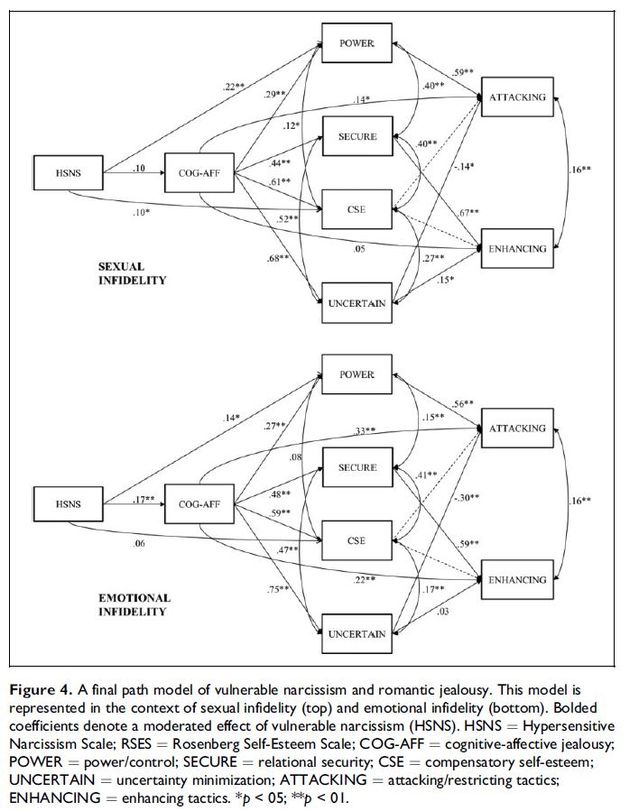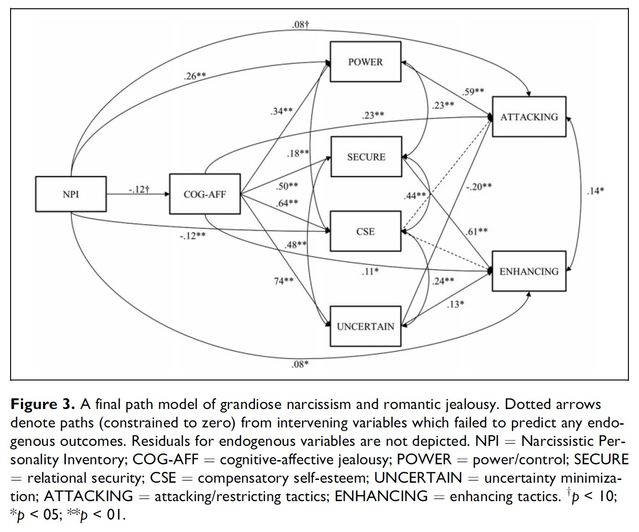Narcissism
Narcissism, Infidelity, and Relationship Motives
Revealing research on how narcissism type shapes people's responses.
Posted July 30, 2018 Reviewed by Davia Sills
"The jealous are troublesome to others, but a torment to themselves." —William Penn
So many of us become involved with narcissistic people who, when they feel threatened by infidelity, become inflamed, jealous, and act in all kinds of troublesome, even dangerous, ways... or, fearing loss, may perform a variety of contortions to try to save the relationship. This is true in romantic relationships and can be extrapolated to other relationships, including work, family, and friendships, in which various forms of interpersonal threat, including from a perceived breach of trust or otherwise, lead to reactive maneuvering, driven by at times by dubious motives.

In the familiar model, there are two brands of narcissism—grandiose and vulnerable. And while they share some features, they are not the same. They tend to overlap with shared feelings of entitlement, a tendency toward antagonism rather than agreeableness, and the use of frank manipulation. When power, control, and self-esteem are on the line, narcissism shapes how we respond.
Grandiose and vulnerable narcissism are different from each other in terms of cognitive and emotional response patterns, self-image, and associated personality traits (Tortoriello & Hart, 2018). In the face of a threat to security, vulnerable narcissism predisposes a person to overreaction, whereas grandiose narcissism is associated with greater stability and fewer feelings of insecurity about oneself.
While vulnerable narcissists tend toward destructive reactions to threats, perhaps due to higher rates of neuroticism, grandiose narcissists are more likely to mobilize constructive responses to threats. While vulnerable narcissism is associated with low self-esteem, strong defensive reactions, and great insecurity and sensitivity to others’ opinions, grandiose narcissism is associated with higher self-esteem and an associated reduced need to use defenses to compensate when slighted, greater assertiveness, and often excessive pride.
However, in spite of the current theories, research has not specifically looked at whether those with greater vulnerable or greater grandiose narcissism respond differently when confronted with the threat of infidelity in an important romantic relationship.
Jealousy 101
In order to better understand how different forms of narcissism are associated with different responses to threats of infidelity, researchers Tortoriello and Hart (2018), veteran investigators into narcissism, developed a study to simulate different relationship infidelity scenarios, looking at how study participants responded as a function of the type of narcissism and related parameters.
The study authors note that there are, according to our current understanding, three kinds of jealousy: cognitive jealousy, worry about imagined or actual threats to the relationship from a rival; emotional jealousy, a group of negative emotional responses, including envy, anger, and fear; and behavioral jealousy, enacted responses to relationship threat, including communications and actions like becoming aggressive toward their partners and/or the rival, surveillance behaviors, seeking revenge, and looking for ways to enhance one’s self image.
They go on further to describe six motivations (Guerrero and Anderson, 1998) related to jealousy, which may be stirred up when relationships are under attack, including trying to maintain the relationship, looking for ways to protect self-esteem, looking for ways to reduce uncertainty (and presumably anxiety) about the future of the relationship and/or the status of the rival, attempting to reevaluate the relationship, and restoring equality in the relationship by retaliating in some way (e.g., hooking up with another person, too). Such “relational motives” are important, because they are persistent, often operate unconsciously, and get strong when relationships are in doubt.
There is an important distinction between “hot” and “cold” responses to an infidelity threat: Hot responses involved inflamed emotions more so than cold responses, which involve more detached, cognitive appraisal. Generally, vulnerable narcissists would presumably be more predisposed to hot responses, and grandiose to more cooler, strategic reactions.
Finally, it’s important to look at different types of infidelity threat, as emotional infidelity may evoke different responses than sexual infidelity. Emotional and sexual infidelity are often thought to be different for men and women, where men are stereotypically thought to be more reactive to sexual infidelity and women to emotional infidelity (though another important factor, not looked at in this study, may be sociosexuality, the tendency toward exclusive versus open relationships, which may cut across biological sex).
A Study in Two Parts
Tortoriello and Hart, after measuring the degree and type of narcissism, presented 269 college undergraduates with vignettes depicting infidelity. To reduce bias by keeping participants from connecting the two phases of the study, they were told that they were participating in two different studies.
In the first part of the study, participants completed the Narcissistic Personality Inventory and the Hypersensitive Narcissism Scale, measures of grandiose and vulnerable narcissism. In the second part of the study, participants were presented with four vignettes simulating either sexual or emotional infidelity in a serious romantic relationship, and were asked to imagine that they themselves were experiencing such a situation. This research methodology has been shown to reliably allow study participants to anticipate how they might really feel, think, and behave in real-world situations. Participants were asked, in reference to the vignettes, about how they would respond and why.
They were asked how much each of the following four relational motives would guide them in the face of infidelity: efforts to restore power and control; efforts to improve weakened feelings of security in the relationship; efforts to bolster injured self-esteem; and efforts to decrease uncertainty about the future of the relationship and where they stood with their partner. Then, the three types of jealous reactions (emotional, cognitive, and behavioral) were assessed, among other things dividing behavioral responses into attacking and/or restricting reactions (e.g., aggression, surveillance, revenge) or enhancing reactions (e.g., efforts to be more attractive to the straying partner).
Findings
The authors found that cognitive jealousy and affective (emotional) jealousy were strongly correlated—basically measuring the same underlying construct—so they simply used “cognitive-affective jealousy,” rather than two categories measuring the same data. The analysis confirmed that grandiose and vulnerable narcissism are distinct concepts, as the Narcissistic Personality Inventory and the Hypersensitive Narcissism Scale results were not correlated. Importantly (see diagrams at the end of the post), while for vulnerable narcissism, sexual and emotional infidelity required two different statistical models, responses to sexual and emotional infidelity were similar with grandiose narcissism.
Grandiose Narcissism
For grandiose narcissism, cognitive-affective jealousy was not related to relational motive. As anticipated, grandiose narcissism is associated with cooler, less emotionally charged and obsessive responses. Cognitive-affective and behavioral jealousy (the tactics which might be used to even the score) were unrelated in grandiose narcissism. The more grandiosely narcissistic the participant, the more likely they were to use attacking and restricting communications and actions, solely out of motives related to power and control. Interestingly, the type of infidelity (emotional versus sexual) did not lead to significant differences in response where grandiose narcissism is concerned.
Vulnerable Narcissism
For emotional infidelity, greater vulnerable narcissism was associated with increased cognitive-affective jealousy. On the other hand, greater vulnerable narcissism did not correlate with increasing cognitive-affective jealousy in the face of sexual infidelity. Vulnerable narcissism directly increased both power and control motives and self-esteem-enhancement motives.
Similar to grandiose narcissism, as vulnerable narcissism increased, sexual infidelity increased attacking and restricting behavioral jealousy, solely out of power and control motives. For emotional infidelity, cognitive-affective jealousy was increased and associated with a diverse blend of motives: power and control, security, self-esteem restoration, and efforts to reduce uncertainty about relationship status.
As vulnerable narcissism increased, emotional infidelity triggered greater cognitive-affective jealousy, leading to enhanced power and control motives, and hence more attacking and restricting tactics. Balancing this increase in attacking and restricting, higher uncertainty-reducing motives tempered attacking and restricting efforts. Lastly, emotional infidelity in vulnerable narcissism connected with increased security motives, and hence increased self-enhancing tactics.
Sex-Based Findings
While men were more emotionally upset than women by sexual infidelity versus emotional infidelity, jealousy itself did not differ with the type of infidelity as a function of sex. Men were more likely than women to get angry following sexual infidelity, but there weren’t any other differences in emotional reactions to the type of infidelity as related to biological sex. Lastly, being male or female did not overall change how the type of narcissism predicted responses to infidelity threats.
Considerations
This research supports the hypothesis that grandiose narcissists are more likely to remain calm, cool, and collected when faced with the threat of infidelity in a romantic relationship than their more vulnerable counterparts. To put it perhaps too simply, those with greater grandiose narcissism don’t care so much whether the infidelity is sexual or emotional, but they don’t like being placed in a potentially unflattering situation. When they are, they will primarily use retaliatory and restrictive tactics to regain power and control. Their self-esteem remains generally intact, so that doesn’t motivate jealousy—that same sturdy self-esteem may also make them blind to issues they bring to the relationship, which ironically might contribute to relationship problems.
On the other hand, those with greater vulnerable narcissism have unsteady self-esteem and neurotic tendencies and get worked up mentally and emotionally when their relationship is under threat. With vulnerable narcissism, emotional infidelity (perhaps triggering deeper insecurity) breeds jealousy more than sexual infidelity. With vulnerable narcissism, jealous actions were motivated by both power and control goals, as well as by efforts to restore flagging self-esteem or fix the relationship.
Sexual infidelity was associated with more retaliatory and suspicious behavior than emotional infidelity. With vulnerable narcissism, there is lower tolerance for relationship uncertainty and insecurity, buffering the desire to retaliate rather than salvage. The fear that vulnerable narcissists may experience when threatened with infidelity, real or imagined, may lead them to be preoccupied and hypersensitive, creating distance and insecurity in the effort to regain intimacy and trust.
If you are tangled up with someone on the more narcissistic side of the personality, sort out whether they are vulnerable or narcissistic. This will give you a better sense of their mental and emotional state, whether they are acting more intentionally or more reactively, and what their motivations are likely to be—notably when it comes to trust issues in relationships.
Future research can sort out whether sex, gender, and sociosexuality relate to narcissistic responses to relationship threats, and look further into causality, rather than correlations, among the different factors governing narcissistic behavior.
Please send questions, topics or themes you'd like me to try and address in future blogs, via my PT bio page.
Statistical Models for Vulnerable and Grandiose Narcissism


References
Guerrero, L. K., & Andersen, P. A. (1998). Jealousy experience and expression in romantic relationships. In P. A. Andersen & L. K. Guerrero (Eds.), Handbook of communication and emotion: Theory, research, applications, and contexts (pp. 155–188). San Diego, CA: Academic Press.
Tortoriello GK & Hart W. Modeling the interplay between narcissism, relational motives, and jealousy-induced responses to infidelity threat. Journal of Social and Personal Relationships, 2018, June 20.




